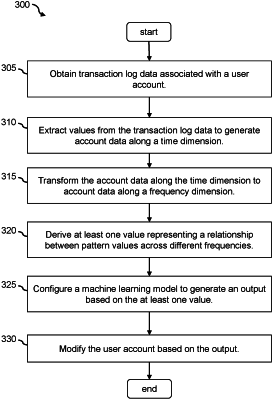| CPC H04L 63/1425 (2013.01) [G06F 16/2228 (2019.01); G06F 16/258 (2019.01); G06Q 20/4016 (2013.01); H04W 12/63 (2021.01)] | 20 Claims |

|
1. A system, comprising:
one or more hardware processors, one or more non-transitory computer-readable memories, with program instructions stored on the one or more non-transitory computer-readable memories, the one or more hardware processors configured to execute the program instructions to cause the system to perform operations comprising:
generating first account data corresponding to a user account, wherein the first account data comprises time series data that corresponds to a first account attribute;
deriving second account data from the first account data, wherein the second account data corresponds to a plurality of account usage frequencies;
determining a plurality of pattern strength values corresponding to the plurality of account usage frequencies based on the second account data, wherein each pattern strength value in the plurality of pattern strength values indicates a corresponding strength of a pattern existing in the first account data according to a corresponding account usage frequency in the plurality of account usage frequencies;
determining (i) a first pattern index based on a first portion of the plurality of pattern strength values that corresponds to a first account usage frequency range and (ii) a second pattern index based on a second portion of the plurality of pattern strength values that corresponds to a second corresponds to an account usage frequency range; and
configuring a decision engine to produce an output indicating a likelihood of anomalous activity associated with the user account using the first pattern index and the second pattern index.
|